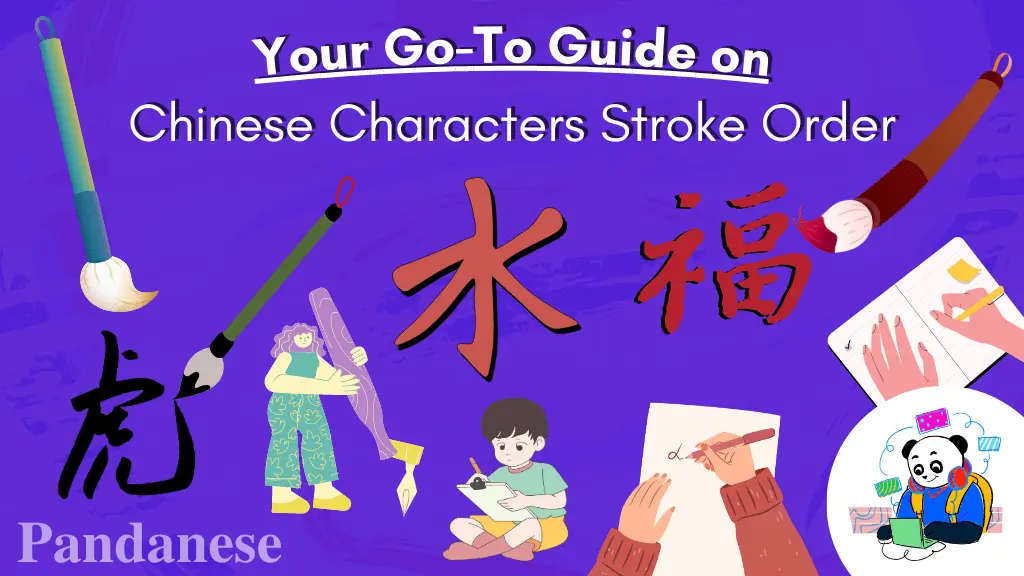
A General Guide To Chinese Character Stroke Order
Have you ever wondered how people write and learn Chinese characters?
Given that some characters, especially traditional Chinese characters, have dozens of strokes, you may wonder if Chinese students follow any particular rules or write as they, please.
The answer is that there is a standard stroke order to follow, but only some write accordingly!
This article will explain why stroke order matters and give you tips on writing characters with the correct stroke order.
What does stroke order mean?
Strokes are dots and lines—the writing movements of a character. Similar in the Japanese kanji characters, the Chinese stroke order called 笔画顺序 (bǐhuà shùnxù) or 笔顺 (bǐshùn), refers to the right and proper way to write both traditional and simplified Chinese characters using strokes.
Many Chinese-language newbie learners question if the order of their strokes matters at all. After all, isn't the goal to write legible Chinese characters? Who cares how you write them?
Well, you should care! Learning stroke order may seem unnecessary, especially in our modern world, when we mostly type in pinyin instead of writing the characters.
But handwriting is here to stay, and stroke order remains extremely important. In my opinion, this is especially true when you first start learning how to write a Hanzi Chinese character. If you learn the correct way to write, your 汉字 will appear more symmetrical and precise, and you will remember them more vividly because you spent more time concentrating on them. Once you've learned some simple characters and paid attention to a few rules, you will find that guessing the correct stroke order will come naturally and will take you far less time.
Eight basic strokes: tips and rules
1. Pay attention to each character's size.
Each character must be contained in a hypothetical square.
Some characters have two parts: in this case, the two components should occupy, more or less, the same space.
Use a square sheet and write each character in a square to practice this. If the squares in your notebook are too small, you can write each character in a 2x2 square.

Generate your own character practice sheet with Purple Culture
You can also purchase notebooks specifically designed to write Chinese characters, but that's not necessary.
2. The horizontal stroke comes before the vertical stroke.
The horizontal strokes are written first when there are horizontal and vertical strokes.
For example, this happens in the characters: 十 (shí, ten), 下 (xià, below), and 木 (mù, tree).

十 stroke order, Strokeorder.info

下 stroke order, Strokeorder.info

木 stroke order, Strokeorder.info
3. The descending stroke on the left before the descending stroke on the right.
Usually, the left vertical stroke is drawn first then the right.
For example, in the characters: 人 (rén, person), 文 (wén, culture), 木 (mù, tree).

人 stroke order, Strokeorder.info

文 stroke order, Strokeorder.info
When vertical strokes cross to form an "X," it's usually top right to bottom left, then top left to bottom right. This motion allows you to write the next character by following the motion of the last stroke.

木 stroke order, Strokeorder.info
4. From top to bottom
The top stroke is written first. Then you work your way down.
Here are some examples in the characters 三 (sān, three)band 森 (sēn, forest).

三 stroke order, Strokeorder.info
This rule also applies to components, not just to individual traits. Thus, in the character 森, consisting of three 木, you will first write the one at the top.

森 stroke order, Strokeorder.info
5. From left to right.
As in the previous case, the rule also applies to individual components.
For example, in the characters: 红 (hóng, red), 林 (lín, forest), 森 (sēn, forest).

红 stroke order, Strokeorder.info

林 stroke order, Strokeorder.info

森 stroke order, Strokeorder.info
6. Outer strokes come before inner strokes.
You can see the stroke order in characters 月 (yuè, moon), 同 (tóng, same), and 问 (wèn, ask).

月 stroke order, Strokeorder.info
When writing the outside stroke, remember to follow the other rules. In this character's case, it's the descending stroke on the left first, then the descending stroke on the right. Afterwards you fill the inside.

同 stroke order, Strokeorder.info

问 stroke order, Strokeorder.info
7. Outer strokes come before inner ones. Then you shall close the frame.
In this case, we are in a closed-frame character. So you follow the previous steps. After completing the inner strokes, the last stroke is to close the frame from left to right.
You can see the examples below in 日 (rì, sun), 四 (sì, four), and 国 (guó, nation).

日 stroke order, Strokeorder.info

四 stroke order, Strokeorder.info

国 stroke order, Strokeorder.info
8. The central stroke comes before the symmetrical side ones.
The central part comes before the two vertically symmetrical characters' components in this case.
This rule applies, for example, to the characters: 小 (xiǎo, small), 水 (shuǐ, water), 办 (bàn, do).

小 stroke order, Strokeorder.info

水 stroke order, Strokeorder.info

办 stroke order, Strokeorder.info
How to practice writing strokes in the correct order
Before you start practicing, make sure you remember all the basic rules above. Some other rules and variations exist, but learning these is enough to start. When you successfully encode them in your mind, practice writing common and easy characters with less than ten strokes.
Keep in mind that whenever you're unsure about the stroke order, check them immediately from your Chinese textbook or in any Chinese stroke order online dictionary like:
The stroke order rules above may seem easy but are sometimes tricky: if you check out some stroke order animations on those websites, you will clear all your doubts.
Doing so will help you memorize the rules better and solidify that knowledge. When you start feeling comfortable writing strokes, and your accuracy is high, level up with more complex characters.
The key is writing Chinese characters every day. For instance, you can do Chinese calligraphy, which is a good practice method. I'm sure that through constant practice, your Chinese characters will look more and more beautiful.
Make learning Chinese easier today!
Stroke order is a great traditional method when writing characters with ease. Once you master your stroke order, focus on building your Chinese vocabulary with Pandanese! It's a web-based app providing mnemonic flashcards and Spaced Repetition System (SRS) curriculum and reviews. Both features are proven memory techniques, helping you remember 6000+ Chinese characters and vocabulary in just a year!
The easiest way to learn Chinese & build vocabulary

